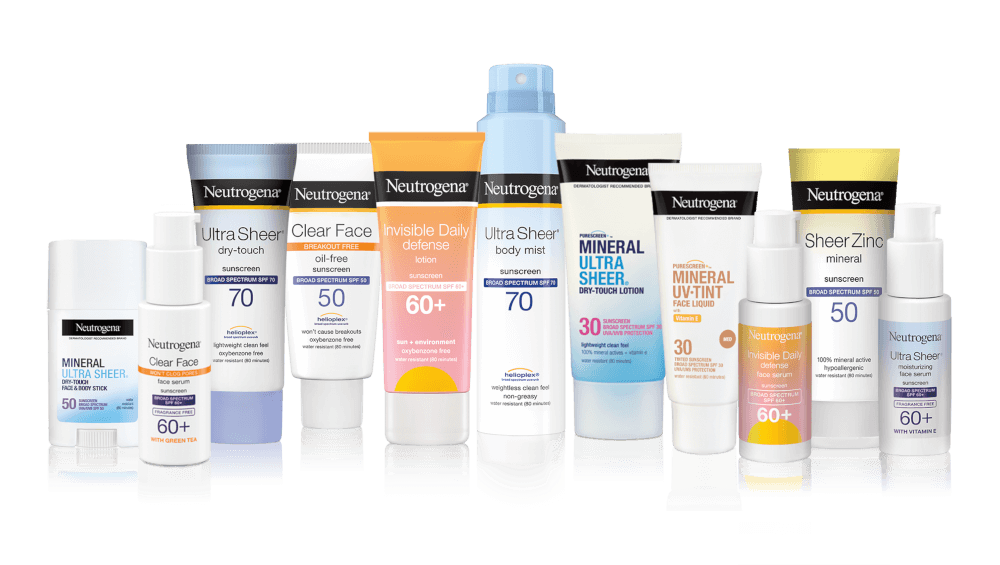
Become a Neutrogena Insider®
Receive news on the latest skincare innovations, sample opportunities, hot topics in literature, patient insights and resources for your patients.

The Care of Aging Skin – Retinol Science
Retinol is one of the most studied ingredients for renewed looking skin and treatment of aging skin.
Since introducing pure stabilized retinol to the US more than 25 years ago, Neutrogena scientists have redefined standards in speed, efficacy, and tolerability of retinol formulations. The latest advancement is Accelerated Retinol SA, a unique combination of retinol, glucose complex and hyaluronic acid that boosts the ingredient’s speed of action for rapid improvement in the appearance of fine lines and wrinkles.
Retinol products are an ideal solution for patients who are not yet ready for prescription retinoids but still want a daily skincare regimen to improve the appearance of fine lines and wrinkles.
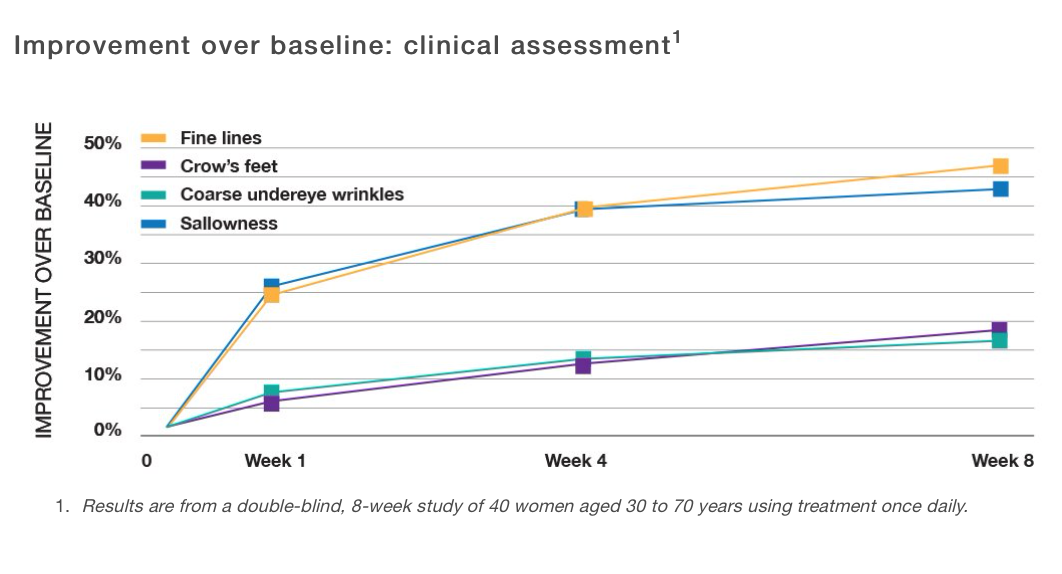

Climate Change Impacts on Skin Barrier
While the value of daily facial cleansing is well-understood, researchers are starting to explore the role of cleansing in removing climate change related particles that weaken the skin barrier.
Research shows that the change in environmental conditions may play a role in contributing to inflammatory dermatoses by exposing the skin to different kind of particles: air particles released via fossil fuel burning, or being a result of expanded pollen seasons, wildfire activity, and urban air stagnation events that trap pollutants in the lower atmosphere. These particles can bind to and weaken the skin barrier, making it more susceptible to UV damage, dryness, wrinkles, and hyperpigmentation.
The practice of daily cleansing can go beyond the existing basis of recommendation, addressing these new researched climate change related particles
References
- 1. Genevieve S Silva, Misha Rosenbach.Climate change and dermatology: An introduction to a special topic, for this special issue.Int J Womens Dermatol. 2021 Jan;7(1):3-7.
- 2. Wendy Roberts. Air pollution and skin disorders.Int J Womens Dermatol. 2020 Nov 25;7(1):91-97.
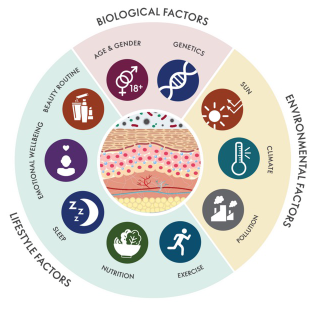
Skincare Routine & Stress
Despite being an external organ, the skin is also exposed to endogenous stimuli, such as hormones, microbiome, and psychological stress.1 Long term psychological stress may lead to skin integrity disruption through disturbance of the epidermal barrier function.²
It is well known that there is a significant association between stress and individuals’ health, including a negative effect on many dermatological diseases.2 In skin aging, chronic psychological stress may stimulate different pathways that may result in chronic immune dysfunction, increased ROS production, and DNA damage, known contributors to skin aging.3
There is also evidence that stress, emotions, sleep deprivation and modern lifestyle impact inflammatory skin diseases such as acne5. Patients with acne often report that their lesions get worse during the stress periods.4 Stress may induce secretion of different neurotransmitters, cytokines and hormones which have skin receptors and can aggravate acne.4
Besides nourishing and protecting overall skin health, a good skincare routine can also simultaneously improve one’s appearance, resulting in a more positive self-perception, increase in confidence, and well-being.
References
- 1. Manuel Molina-García, Corinne Granger, Carles Trullàs, Susana Puig. Exposome and Skin: Part 1. Bibliometric Analysis and Review of the Impact of Exposome Approaches on Dermatology. Dermatol Ther (Heidelb). 2022 Feb;12(2):345-359.
- 2. Ia Khmaladze, Michele Leonardi, Susanne Fabre, Cyril Messaraa, Alain Mavon.The Skin Interactome: A Holistic "Genome-Microbiome-Exposome" Approach to Understand and Modulate Skin Health and Aging.Clin Cosmet Investig Dermatol. 2020 Dec 24;13:1021-1040.
- 3. Jean Krutmann, Anne Bouloc, Gabrielle Sore, Bruno A Bernard, Thierry Passeron. The skin aging exposome. J Dermatol Sci. 2017 Mar;85(3):152-161.
- 4. R G R Albuquerque, M A D Rocha, E Bagatin, S Tufik, M L Andersen. Could adult female acne be associated with modern life?.Arch Dermatol Res. 2014 Oct;306(8):683-8.
- 5. B Dréno, V Bettoli, E Araviiskaia, M Sanchez Viera, A Bouloc. The influence of exposome on acne.J Eur Acad Dermatol Venereol. 2018 May;32(5):812-819.
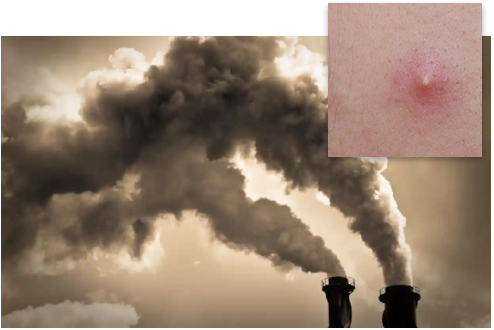
Pollution Exacerbates Acne
There is growing evidence that exposure to airborne pollutants such as ozone (O3), nitrogen dioxide (NO2) and sulfur dioxide (SO2) generates oxidative stress by means of reactive oxygen species ROS and inflammation and induces severe alterations of the normal functions of lipids, deoxyribonucleic acid and/or proteins in the human skin. This can contribute to a background inflammatory environment and disrupt the skin barrier.1,2
This phenomenon is more pronounced in acne patients1. Indeed, pollution induced oxidative stress is thought to be the trigger that sets off the acne cascade causing keratinocyte hyperproliferation and inflammatory cytokine release.2,3
Additionally, some recent research suggests that exposure to high levels of outdoor pollution would overwhelm acne skin’s natural defenses, depleting its antioxidants capacity (such as Vitamin E).3
As pollution can exacerbate acne, a good acne daily skincare regimen should include applying a daily protective barrier enriched in topical antioxidants and thorough day and night cleansing to remove pollution particles that accumulate on the skin during the day.
References
- 1. B Dréno, V Bettoli, E Araviiskaia, M Sanchez Viera, A Bouloc. The influence of exposome on acne.J Eur Acad Dermatol Venereol. 2018 May;32(5):812-819
- 2. Claudia El Haddad, Nour Estelle Gerbaka, Souheil Hallit, Carmen Tabet: Association between exposure to ambient air pollution and occurrence of inflammatory acne in the adult population. BMC Public Health.2021; 21: 1664.
- 3. Jean Krutmann and al: Pollution and acne: is there a link?. Clin Cosmet Investig Dermatol. 2017 May 19;10:199-204.
Diversity in Photoprotection
Did you know patients of different ethnicities experience sunburn differently?
According to a recent survey, while sunburns occur less often in darker skin tones, they were reported to be more severe and painful for those with Fitzpatrick Type V-VI1.
The link between sun exposure and skin cancer is a concern for all skin types. But for patients with darker skin tones, UVA, UVB and visible light can also induce hyperpigmentation and exacerbate pigmentary disorders2.
Research has shown tinted sunscreens, which contain iron oxide pigments, protect against visible light and helps pigmentary conditions due to UV exposure in darker skin tones.2-3 Antioxidants like Vitamin E and feverfew can also help boost the skin’s natural defenses.
Learn more about the diverse portfolio of Neutrogena® sunscreens.
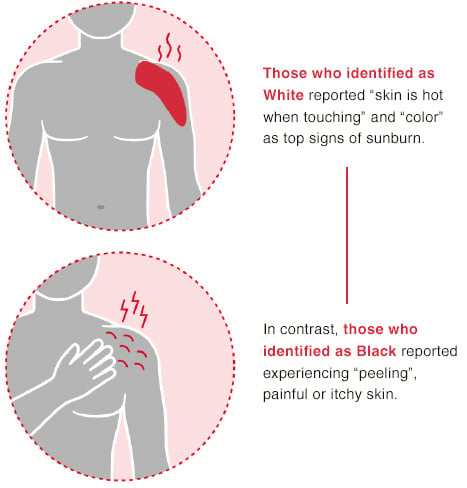
References
- 1. Hartman CL, Linkner R, Kizoulis M. Relevant OTC skincare solutions for multicultural consumers. Paper presented at: Skin of Color Update 2020 Virtual Meeting; September 12-13, 2020
- 2. Rigel DS,Taylor SC, Lim HW,Alexis AF,Armstrong AW,ChiesaFuxench ZC,Draelos ZD,HamzaviI H.Photoprotection for skin of all color: Consensus and clinical guidance from an expert panel.JAmAcadDermatol.2022 Mar;86(3S):S1-S8. doi: 10.1016/j.jaad.2021.12.019. Epub 2021 Dec 20. PMID: 34942296.
- 3. Taylor SC, Alexis AF, Armstrong AW, Chiesa Fuxench ZC, Lim HW. Misconceptions of photoprotection in skin of color. J Am Acad Dermatol. 2022 Mar;86(3S):S9-S17. doi: 10.1016/j.jaad.2021.12.020. Epub 2021 Dec 21. PMID: 34942293
Psychology of Acne
Acne can be a stressful skin condition with significant negative impact on quality of life, regardless of gender or age. Neutrogena scientists wanted to learn more about the state-of-mind surrounding this common condition. They conducted research with 100+ acne sufferers ages 13-45 to understand what they felt was the “worst thing” about having acne. The responses can be enlightening for dealing with the sensitive life issues that concern acne patients.
Researchers identified 3 major themes:

When looking at teenagers (age 13-17), 66% focused on the emotional aspects of acne, while 33% focused on the physical manifestations. Females reported more “sadness,” while males used more angry words.
Explore patient resources and acne solutions from Neutrogena®.
References
- Coubart A, Richtmyer M, Gardner W, Montoya C, Kizoulis M, Oana Cula G, Batchvarova N. Profiling Acne Sufferers: From Acne Types/Severity to Impact on Personal and Social Life. Presented at the American Academy of Dermatology Virtual Annual Meeting, 23-25 April 2021
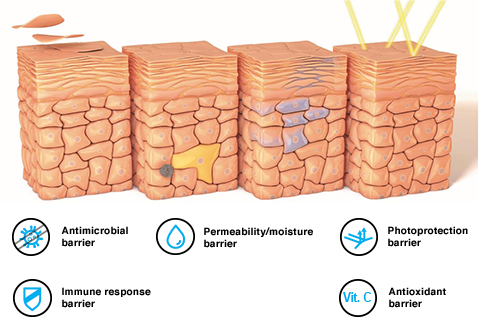
The Dynamic Skin Barrier
Our skin barrier is more than brick and mortar.
The skin is a dynamic, continually self-renewing organ that is also capable of self-repair. The epidermis performs many closely interconnected and co-regulated barrier functions mainly localized to the stratum corneum.
External and internal factors can create imbalance and damage to the skin barrier, including climate, sun damage, age, ethnicity … and choice of skincare.
For optimum skin health, advise patients to choose high quality products for cleansing, hydration, treatment and protection – with ingredients and technologies that are gentle to the skin barrier.
Learn more about the full portfolio of Neutrogena® skincare, formulated to respect the skin barrier.
References
- Del Rosso JQ et al. J Clin Aesthet Dermatol 2011;4:22−42; 2. Baroni A et al. Clin Dermatol 2012;30:257−62

Potential Skin Impacts of Visible Light & Long UVA1
The synergistic effects of Visible Light and long wavelength UVA1 ( VL + UVA1) on inducing pigmentation and erythema in skin have been demonstrated and linked to exacerbation of dermatologic condition including melasma and post-inflammatory hyperpigmentation. This is an observation that is more common in individuals with dark skin phenotypes.1
Recent studies have demonstrated that the combination VL+UVA1 was able to cause intense and long lasting pigmentation in dark-skinned individuals (skin phototypes IV-VI) and erythema in light-skinned individuals (skin phototypes I-III). This is a novel finding given the erythemogenic spectrum of sunlight has primarily been attributed to ultraviolet B (290-320 nm) and short wavelength UVA2 (320-340 nm) only.2
With VL+UVA1 induced effects primarily being mediated by reactive oxygen species (ROS)1, new data suggest a potential role for topical antioxidants to be incorporated in photoprotection to help inhibit erythema in SPT I-III and to reduce pigmentation in SPT IV-V caused by VL+UVA1.3
Photoprotection solutions with antioxidants can help prevent the worsening of pigmentary disorders and boost skin natural defenses against the oxidation caused by Visible Light and Long UVA.
References
- 1. Eduardo Ruvolo, Wyatt Boothby-Shoemaker, Nishant Kumar, Iltefat H Hamzavi, Henry W Lim, Indermeet Kohli : Evaluation of efficacy of antioxidant-enriched sunscreen products against long wavelength ultraviolet A1 and visible light. Int J Cosmet Sci.2022 May 19.
- 2. Nneamaka Ezekwe, Jalal Maghfour, Indermeet Kohli: Visible Light and the Skin.Photochem Photobiol. 2022 Apr 16. 3. Alexis B Lyons, Raheel Zubair, Indermeet Kohli, Amanda F Nahhas, Taylor L Braunberger, Mohsen Mokhtari and al.Mitigating Visible Light and Long Wavelength UVA1-induced Effects with Topical Antioxidants.Photochem Photobiol. 2022 Mar;98(2):455-460.

Cleansing To Minimize Impact of Pollution
Pollution has been shown to increasingly play a role in some of the most common skin diseases including acne, hyperpigmentation, atopic dermatitis, and psoriasis1.
Air pollution particles may enter the skin through different paths, generate free radicals and oxidative stress, inducing an inflammatory cascade causing a subsequent impairment of the skin barrier (2). These effects can be amplified by the deleterious synergy between pollution and sunlight. Repeated and frequent exposure to high levels of these pollutants may lead to premature aging, photodamage and increased incidences of atopic dermatitis, acne and other skin conditions1.
Twice-daily cleansing can combat the effects of pollution on the skin – potentially mitigating pollution-related skin disorders1. The morning cleanse prepares the face for the anticipated environmental impacts of the day. The evening cleanse should be longer as it’s designed to remove airborne particles, soot, and other possible skin contaminants that may lie on the skin surface.
Minimizing the impact of pollutants starts with cleansing!
References
- 1. Wendy Roberts. Air pollution and skin disorders.Int J Womens Dermatol. 2020 Nov 25;7(1):91-97. 2. S E Mancebo,S Q Wang. Recognizing the impact of ambient air pollution on skin health.J Eur Acad Dermatol Venereol. 2015 Dec;29(12):2326-32.
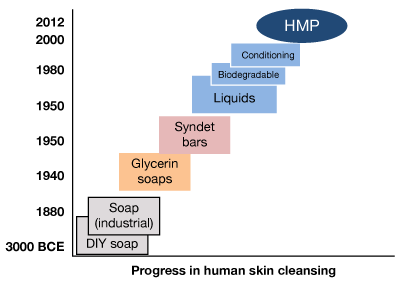
Advances in Cleansing Chemistry
HMP (hydrophobically modified polymers): A breakthrough technology in advancing the science of cleansing.
Humans have been cleansing their skin with surfactants for millennia and generally the progress in cleansing technology has been marked by the creation of cleansing systems that better respect the skin barrier. While the industrial revolution brought purer soap, the high pH and aggressiveness that came with this new product motivated the development of new, gentler technologies. The addition of glycerin to cleansers, to make for milder cleansing systems, marked the first significant advance in skin cleansing.
After World War, the development of new synthetic chemistries enabled many advances in milder cleansing. Developed in the 1950s, the lower pH syndet bar was introduced as an alternative cleanser to soap. The syndet bar has been shown to better respect the skin barrier than soap bars. In the 1960s, polymers were added to cleansers for the first time for multiple benefits.1
The more recent introduction of HMP (hydrophobically modified polymers) into surfactant systems allows for a new approach to creating cleansers with reduced impact to the skin barrier. New cleansing formulations containing HMP respect the skin integrity by facilitating the assembly of surfactants into larger, more stable structures that are less likely to penetrate the skin, thereby resulting in less aggressive but effective cleansers.1
References
- 1. Russel M Walters, Guangru Mao, Euen T Gunn, Sidney Hornby.Cleansing formulations that respect skin barrier integrity.Dermatol Res Pract. 2012;2012:495917.
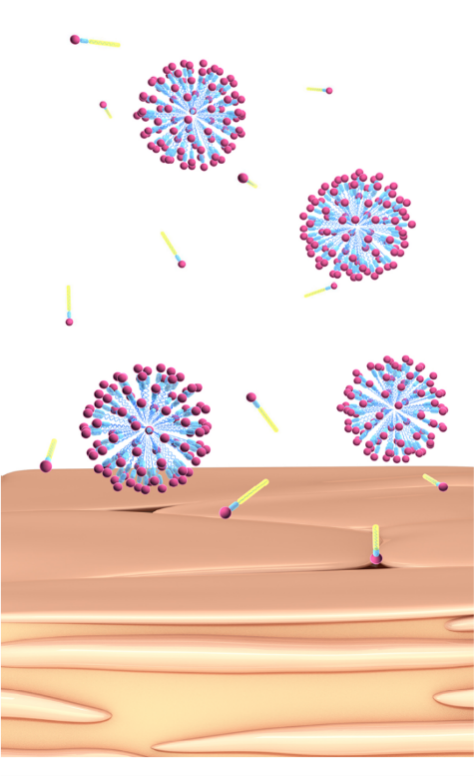
Avoid Chronic Surfactant Exposure
Every day, the skin barrier is bombarded with external stressors … dirt, oil, UV rays, makeup, and even pollution. Many patients add yet another aggressor with their choice of facial cleanser.
Harsh cleansers are a common cause of skin barrier damage1. Surfactants – the molecules responsible for removing the dirt - can disrupt the lipid barrier and penetrate the stratum corneum, causing inflammation, dryness and oxidative stress2,3. The problem is exacerbated for patients who already have compromised skin barrier integrity from acne, atopic dermatitis, eczema or rosacea4.
Advise patients to choose a gentle cleanser to start their skincare regimen and support a healthy skin barrier.
Learn about the gentle cleansing solutions from Neutrogena®.
References
- 1. Del Rosso JQ, Levin J. The clinical relevance of maintaining the functional integrity of the stratum corneum in both health and disease-affected skin. J Clin Aesthet Dermatol. 2011;4(9):22-42.
- 2. Walters RM, Mao G, Gunn ET, Hornby S. Cleansing formulations that respect skin barrier integrity. Dermatol Res Pract. 2012;2012:495917. doi: 10.1155/2012/495917. Epub 2012 Aug 13. PMID: 22927835; PMCID: PMC3425021.
- 3. Kirchner et al. Evaluation of the Mildness Potential of Liquid Cleansers. AAD 2020 Poster#18567.
- 4. Draelos Z, Hornby S, Walters RM, Appa T. Hydrophobically modified polymers can minimize skin irritation potential caused by surfactant-based cleansers. J Cosmet Dermatol. 2013;12(4);314-321.
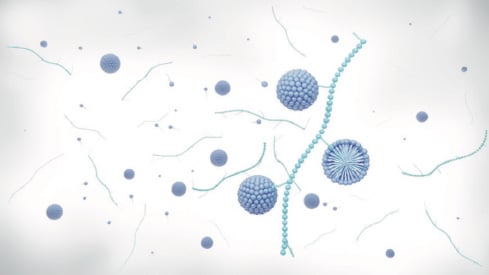
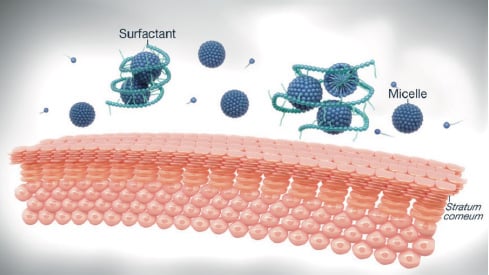
An Evolution in Cleansing Technology
Gentle cleansing is particularly important for patients with acne, atopic dermatitis eczema, rosacea, and other dermatologic conditions that may cause compromised skin barrier integrity.4 Surfactant selection often represents a trade-off between functionality, esthetics, and mildness.
Typical cleanser surfactants capture dirt and oil to create droplets known as micelles. Although designed to rinse away, surfactants can also break through the skin barrier, causing inflammation. Adding hydrophobically modified polymers (HMPs) to cleansers that contain surfactants can help to create polymer-surfactant complexes that are less irritating to the SC lipid barrier.1-3
Hydrophobically Modified Polymers (HMPs) bind to the surfactant to organize micelles into larger molecules, minimizing penetration into the stratum corneum. Natrasurf® technology uses naturally-derived, starch-based polymeric surfactants to surround the micelles, generating the foaming aesthetics patients love. When paired together, these polymeric systems deliver lather-rich cleansers that minimize surfactant penetration and barrier disruption.3
In a recent clinical study, a cleanser formulated with HMP resulted in a 43% reduction in skin irritation potential versus a control cleanser without HMP.1
Learn more about the new polymeric cleansers from Neutrogena®.
References
- 1. Draelos ZD. The science behind skin care: Cleansers. J Cosmet Dermatol. 2018 Feb;17(1):8-14. doi: 10.1111/jocd.12469. Epub 2017 Dec 12. PMID: 29231284.
- 2. Hornby S, Walters R, Tierney N, Appa Y, Dorfman G, Kamath Y. Effect of commercial cleansers on skin barrier permeability. Skin Res Technol. 2016 May;22(2):196-202. doi: 10.1111/srt.12250. Epub 2015 Jun 10. PMID: 26094702.
- 3. Tierney, N. et al. Cleansers with Hydrophobically-Modified Polymers Demonstrate Improved Mildness and Skin Barrier Integrity. American Academy of Dermatology, 69th Annual Meeting. February 2011. New Orleans, LA
- 4. Draelos ZD. The science behind skin care: Cleansers. J Cosmet Dermatol. 2018 Feb;17(1):8-14. doi: 10.1111/jocd.12469. Epub 2017 Dec 12. PMID: 29231284.


All Fields required, unless otherwise indicated
Will be used as your user name
By submitting your information above, you agree that the information you provide will be governed by our site's Privacy Policy.